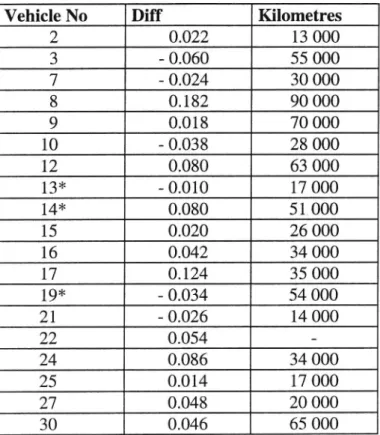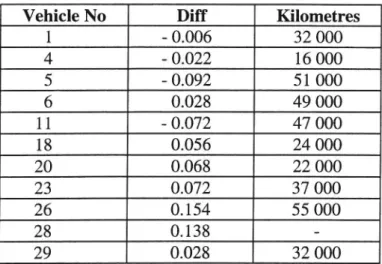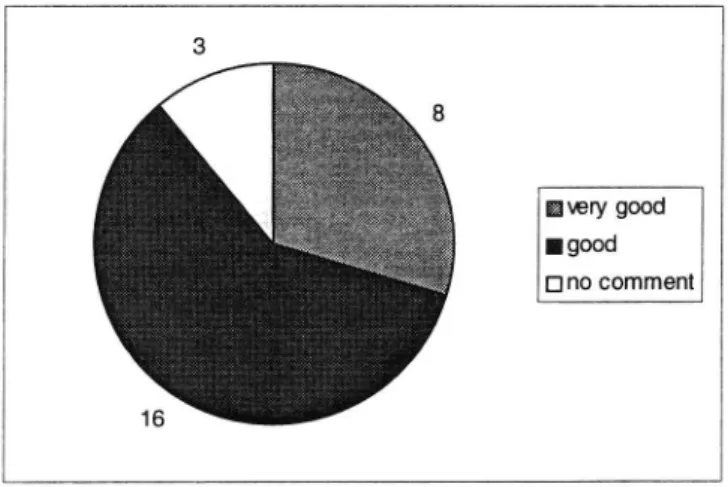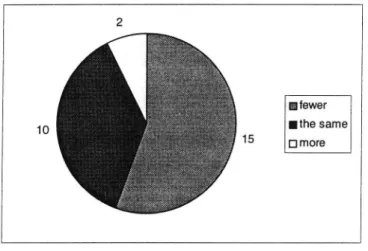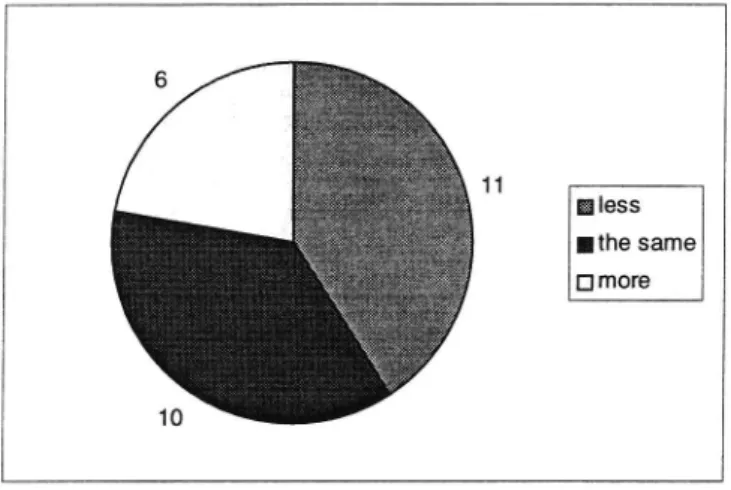VT1 notat
Number: 19A-1995 Date: 30 Augusti 1995
Title: Safety groove effect on windscreen wear and dirt accumulation
Author: Katja Jingryd
Resource group: Traffic technology Project number: 20226
Project name: Grooves in windscreens
Commissioner: Vägverket (Swedish Roads Authority) Distribution: Unlimited div Väg- och transport-forskningsinstitutet ä
FOREWORD
The "Grooves in windscreens" project has been paid for by Vägverket/Skyltfonden (Road-Sign Maintenance Fund) with Petra Åkerlund as contact person. Project manager was Sven-Olof Lundkvist and measurements were carried out by the undersigned. I am indebted to the following for their help: Pilkington Bilglas AB in Landskrona who provided new windscreens and lent us their measuring instruments; Uno Ytterbom who helped me to start up the measurement equipment; Säkerhetsráman AB who booked in the trial vehicles and in addition provided assistance during the measuring process; Kron Recond in Göteborg who were kind enough to provide premises both in their workshops and their
coffee-rooms. And, ñnally, thanks also to Bilspedition, EKA Nobel, Ericsson, ESAB,
Pripps, Pååls, Taxi Göteborg and Telia who all provided trial vehicles and subjected themselves to the inconvenience of turning up for the various measurements .
Katja Jingryd
CONTENTS Page _ SUMMARY I 1 BACKGROUND 1 2 PURPOSE 2 3 METHOD 2 3. 1 General 2 3 .2 Wear 2 3 .3 Function 3 4 IMPLEMENTATION 3 5 INTERMEDIATE MEASUREMENT 3 5.1 General 3 5 .2 Wear 3 5 .3 Function 4 5.4 Evaluation 4 6 FINAL MEASUREMENT 5 6. 1 General 5 6.2 Wear 5 6.3 Function 9 7 CONCLUSIONS 12 8 REFERENCES 1 3
The effect of the safety groove on windscreen wear and dirt accumulation by Katja Jingryd
Swedish Road and Transport Research Institute (VTI) 8-581 95 LINKÖPING
Sweden
SUMMARY
Just about every motorist has at one time or another experienced the inconvenience of streaks of water and/or a film of dirt on the windscreen. Many car-drivers have almost certainly also experienced the discomfort of meeting oncoming traffic in the dark and being blinded by reflections in the windscreen. This is because the light beams from the oncoming traffic are refracted partly by dirt on the windscreen but also owing to defects in the windscreen glass.
This study aims at analysing the effect of the safety grooves (two grooves in the windscreen whose purpose is to clean the wiper blades as they pass them) and their effect on cleaning and wear of the windscreen. In addition, it is of interest to study whether or not one can expect any environmental effect since there is greater scope for being able to use clean water as washer fluid and wash away dirt on the windscreen and wiper blades instead of using solvents containing environmentally hazardous Chemicals. The vehicles in the study were fitted with new windscreens which featured one groove on one side of the windscreen. On the assumption that the entire windscreen is subjected to the same degree of wear/dirt accumulation, the conventional half of the windscreen thus functioned as a reference unit forthe other half. Wear was analysed by establishing the windscreens' SLI-value (Stray Light Index) using a Timmermann instrument. Other aspects of the groove's function were analysed with the help of a questionnaire.
The survey shows a significant reduction in wear onthat side of the windscreen which had the safety groove. The questionnaire shows that almost 90% of vehicle owners in this trial felt that the safety groove was a good feature and most of them acknowledged a considerable improvement in visibility. As regards extension of wiper blade service life, the tendency is positive although no direct conclusions can be drawn regarding the consumption of washer fluid.
1 BACKGROUND
Almost every motorist has at some time or another experienced the inconvenience of streaks of water and/or a film of dirt on the windscreen. Many car-drivers have almost certainly also experienced the discomfort of meeting oncoming traffic in dark and being blinded by reflections in the windscreen. This is because the light beams from the oncoming traffic are refracted partly by dirt on the windscreen but also owing to defects in the windscreen glass. The way in which the windscreen's degree of wear affects the driver's vision has been surveyed by VTI (Helmers & Lundkvist 1988, ditto 1993) and it has been observed, among other things, that a very wom windscreen results in a 15-20% reduced field of visibility when approaching simulated pedestrians in the dark.
Two grooves etched into the windscreen, whose purpose is to clean the wiper blades as they pass, is an old Finnish invention dating back more than twenty years. Laboratory tests show not only an improvement in the function of the wiper blades and extended service life but also reduced wear of the windscreen itself. At the same time it was observed that this measure does not in any way impair durability in terms of any
side-effects (Heinonen & Kivalo, Technical Research Centre of Finland, 1975). It would thus
appear that a windscreen groove would be able to reduce both the negative effects of traffic film accumulation on the windscreen's optical properties and the wear which is caused through pulverisation of the small particles which accompany the wiper blades during their movement. In addition, there would be greater scope for using clean water as a washer fluid to wash away dirt on the windscreen and wiper blades instead of using solvents consisting of environmentally hazardous Chemicals.
The safety groove or in its Swedish patent version "Säkerhetsräfflan" was implemented in a preliminary study in spring 1992 on a number of passenger cars in VTI's vehicle fleet. After one winter there was a clear indication of the wear reduction effect and the results were considered to be sufficiently interesting to continue the trial on a more widespread basis.
2 PURPOSE
The purpose of this study is to investigate the Cleaning and wear-reduction effect of grooves etched into the windscreen. In addition, it is of interest to study whether one can expect any environmental side-effect owing to the more mechanical rather than chemical cleaning process which can be used.
3 METHOD
3.1 General
The vehicles in the study were given one groove on one side of the windscreen whereupon the conventional side of the windscreen functioned as a reference panel in comparison with the new system. The groove was made on the driver's side (the left side) on some vehicles while others had the groove on the passenger side (the right side). This was done so as to monitor any possible differences between right/left sides of the windscreen owing to the fact that Sweden has left-hand drive traffic.
3.2 Wear
An assessment of windscreen condition was previously done through contrast measurements in the laboratory (Lundkvist, Helmers & LÖfving, 1987) but is nowadays
done with a Timmermann instrument. The methods are similar (Lundkvist, Ytterbom &
Helmers, 1988) but show a considerable difference in practical implementation. Contrast measurement requires that the windscreen is removed from the vehicle whereas the Timmermann approach can be used with the windscreen fitted in the car. Windscreen wear was thus checked by establishing the SLI-value (Stray Light Index) using the Timmermann instrument. In simple terms, this method relies on the fact that a faultless windscreen allows a light beam to penetrate virtually straight through whereas light is broken up and refracted to varying degrees if the windscreen has any defects. In general terms, the SLI-value can be said to indicate how much refracted light is measured in the area around the point where most of the light would have passed if the windscreen had been free from scratches and/or craters. A windscreen with a high SLI-value is thus exposed to greater wear than a windscreen with a lower SLI-rating.
3.3 Function
Other aspects of the safety groove's function were investigated with the help of a
questionnaire. In conjunction with windscreen replacement, the vehicle owners were
asked to estimate their consumption of washer fluid and wiper blades during the past year. At the final measurement they were asked to respond to the same questions again. The Cleaning effect was assessed subjectively in that the driver of the vehicle was asked to assess how he or she felt the system had functioned.
4 IMPLEMENTATION
Between March and May 1994 forty passenger cars (both privately owned and company owned) and five trucks were fltted with new windscreens equipped with a 0.3 mm deep groove. An initial measurement was carried out on roughly half of the trial vehicles before the winter with the purpose of showing any trends which could be discerned. The final measurements one year after windscreen replacement were designed to include all the vehicles, but for a variety of reasons this was not possible. Some of this shortfall stemmed from the fact that some of the vehicles received new windscreens following stone-chip damage. Others had been sold during the intervening year and the new
owners could not be contacted for final measurement, and a few others were not
available for measurement during the relevant week. The final measurement thus encompasses 30 vehicles, three of which are trucks.
5 INTERMEDIATE MEASUREMENT
5.1 General
This measurement encompassed 18 vehicles and was carried out in November 1994, roughly 7 months after the windscreens were replaced. The purpose was to establish the general tendency so the results are not presented in detail. The measurement system is described in detail in section 6.1.
5.2 Wear
Half the windscreens showed less wear on the side where the windscreen wipers had been scraped clean by the groove, whereas the results were the reverse on the other half of the windscreens. Regression analysis could not show any connection to the mileage
wear on the grooved side was generally less even if the difference was small. If we examine the left and right sides we see that wear on the right side was the same irrespective of whether it was equipped with a groove or not, whereas the left side showed greater wear if there was no groove.
5.3 Function
When the vehicle owners were asked to provide an overall assessment of the groove's function, eleven of them thought the groove functioned well and six felt that it functioned extremely well. Only one person responded "not good" in response to this question, but pointed out that it was rather difficult to observe any difference at all since the groove on his vehicle was on the passenger side. This may, of course, make any comparison difficult and this is further emphasised by the fact that only one of the six who responded "very good" had the groove on the right side. This person made the comment that he deliberately checked every now and again and this was something that many of the others indicated that they had not considered. As regards visibility improvements in specific contexts, the most notable effect was a reduction in water streaks. When asked about any negative effects only one respondent replied that there were any negative effects. This person felt that the wiper blades were wom more quickly but he had no objective proof on which to base his assertion.
5.4 Evaluation
The first measurement results were thus to the advantage of the safety groove. However,
the wear differences which were observed were not significant (p<0.05): a t-test cannot
show any effect of the groove, or the side to which it is fitted. Other vehicle drivers' subjective assessments were generally positive. At the time of the intermediate measurement the windscreens were only about half a year old and the weather in summer 1994 did not require very frequent use of the windscreen wipers. This latter aspect probably explains the generally low ratings which were obtained during this part of the study.
6 FINAL MEASUREMENT
6.1 General
The final measurement was carried out in March 1995, roughly one year after the start of the trial. The windscreens' SLI-value was measured at ten points for each of the vehicles, five on the side with the groove and five on the side without the groove. The Timmermann instrument indicates both the highest value (SLI-peak) and the mean value (SLI-mean) of the refracted light Spread which is found within the measurement area. In other words, the first measurement value shows the effect of the worst damage (for example stone-chip damage) whereas the second value shows a kind of mean effect of all the existing defects. Since what is of most interest is a general picture of windscreen wear, only SLI-mean is discussed in the presentation below and this is expressed in Simplified form as SLI.
All statistical analyses were carried out at 95% level, that is to say that for values which
are considered significant, it has been shown that p<0.05.
6.2 Wear
The results from the Timmermann measurements are shown in the following two tables, one for the 19 vehicles with the groove on the left and one for the 11 vehicles with the groove on the right. SLI is given as a mean value of five measurement ratings.
Table 1 Results of Timmermann measurements on 19 windscreens with the
groove on the left side (driver's side). SLI on the side with and without the groove respectively is given as a mean value of five measurements.
The asterisk indicates that the vehicle is a truck. SLI on the side
Vehicle No with groove without groove
2 0.62 0.64 3 0.99 0.93 7 0.69 0.67 8 0.69 0.87 9 0.72 0.73 10 0.67 0.63 12 0.70 0.78 13* 0.31 0.30 14* 0.47 0.55 15 0.62 0.64 16 1.01 1.05 17 0.88 1.01 19* 0.38 0.34 21 0.67 0.65 22 0.79 0.84 24 0.56 0.65 25 0.81 0.83 27 0.96 1.00 30 0.99 1.04
_T_abl_e2 Result of Timmermann measurements on 11 windscreens with the
groove on the right side (passenger side). SLI on the side with and without the groove respectively given as a mean value of five measurements.
SLI on the side
Vehicle No with groove without groove
1 0.96 0.95 4 0.66 0.64 5 1.15 1.06 6 0.69 0.72 11 0.94 0.87 18 0.72 0.78 20 0.79 0.85 23 0.52 0.59 26 0.79 0.94 28 1.11 1.24 29 1.01 1.04
In order to study whether or not the safety groove gives rise to reduced wear or not, we decided to compare the SLI for the grooved and the non-grooved sides of all the vehicles in the test. The values in the tables show, however, that the various windscreens have been subjected to different rates of wear which means that in addition to variations within the various vehicles there is also a degree of variation between individual vehicles. Since it is the former difference which is of interest here, we study the difference between the SLI on the non-grooved and grooved side instead of the absolute SLI-values and this is shown in the following two tables. The tables also show the approximate mileage which each vehicle has covered since the windscreens were replaced.
Table 3 Results of Timmermann measurements on 19 windscreens with the groove on the left side (driver's side). Diff = (SLI on the side without the groove, mean value of five measurements) - (SLI on the side with the
groove, mean value of five measurements). An asterisk indicates that the
vehicle is a truck.
Vehicle N0 Diff Kilometres
2 0.022 13 000 3 - 0.060 55 000 7 - 0.024 30 000 8 0.182 90 000 9 0.018 70 000 10 - 0.038 28 000 12 0.080 63 000 13* -0.010 17 000 14* 0.080 51000 15 0.020 26 000 16 0.042 34 000 17 0.124 35 000 19* - 0.034 54 000 21 - 0.026 14 000 22 0.054 -24 0.086 34 000 25 0.014 17 000 27 0.048 20 000 30 0.046 65 000
Table 4 Results of Timmermann measurements on 11 windscreens with the groove on the right side (passenger side). Diff = (SLI on the side without the groove, mean value of five measurements) - (SLI-mean on the side with the groove, mean value of five measurements).
Vehicle No Diff Kilometres 1 - 0.006 32 000 4 - 0.022 16 000 5 - 0.092 51 000 6 0.028 49 000 11 - 0.072 47 000 18 0.056 24 000 20 0.068 22 000 23 0.072 37 000 26 0.154 55 000 28 0.138 -29 0.028 32 000
At this point it is suitable to study whether there is any significance in the fact that the 30 windscreens have grooves on different sides - 19 on the driver's side, 11 on the passenger's side. In addition, 3 of the 19 vehicles with the groove on the left side are trucks. The double-sided t-test shows that there is no significant effect of the location of the groove (on the left or the right side) nor type of vehicle, so all the vehicles are regarded as belonging to one and the same category in the on-going analysis.
In the definition of Diff a plus sign indicates that the side of the windscreen which has the safety groove shows less wear, which is the case for 20 of the 30 vehicles in the test. For the population as a whole (meanvalue of 30 mean values) the wear on the grooved
side was less: Diffmf,an = 0.0325 with standard deviation 0.066. The quotient in a
double-sided t-test with 29 degrees of freedom for a significance of 95% should exceed 2.05. In this particular case the value is 2.70 so the observed difference is significant. As regards correlation between wear and mileage no significant connection could be shown.
6.3 Function
For various reasons, it was not always possible for the vehicle user to come in with the vehicle for the measurement so we were not only faced with missing trial vehicles but also an inability to receive answers to our questionnaires. The final results showed 27 respondents. Since the questionnaire is extremely general the presentation is limited to an overview of the results.
The majority of drivers was satisfied with the safety groove and only three of the respondents said that they had not noticed any difference. What is interesting is that all of them had driven, for the most part, in city traffic during the test. Compared with highway driving we see a different pattern of dirt accumulation on the windscreen (different environment, lower speeds). What is more, the driver spends a shorter time in the vehicle on each occasion. Of the eight drivers who thought that the groove was excellent five drove for the most part on highways. Is it possible that city traffic conditions "mask" a possible effect? It is extremely difficult to sustain an examination in this direction owing to the limited scope of the questionnaire. However, what can be said to have a more direct effect on the drivers' appreciation of the safety groove is its location. It is naturally easier to note any difference if the groove is within the normal area of visibility and the eight respondents who felt that it had functioned extremely well all had the groove on the driver's side. Figure l below shows the various reactions to the function of the safety groove.
very good
I good
I] no comment
Figure l Safety groove function. The diagram shows a total of 27 respondents. Fifteen drivers had fewer wiper blade changes during the trial year compared with the year before. Nine of these had not replaced their wiper blades at all, which at first glance may seem somewhat odd. If the groove extends the service life of the wiper blades then the wiper blade on the side without the groove should be replaced at the normal interval. However, closer investigation showed that seven of these nine had the
10
groove on the left side and any possible impaired visibility on the passenger side was perhaps not enough of a problem to prompt wiper blade replacement. Three of the fifteen drivers replaced their wiper blades fewer times on the side with the groove during the trial period. All of them had the groove on the right side of the windscreen and thought that there was a clear drop in visibility on the driver's side. Another vehicle owner (groove on the left side) switched the wiper blades around every time his wife felt that visibility on the passenger side was impaired, upon which the poorer wiper blade was sharpened once again. The results for wiper blade consumption are shown in figure 2 below.
fewer
.the same
Elmore
Figure 2 The number of wiper blade replacements during the trial year compared with the previous year. The results are taken from 27 respondents.
As regards wiper blades most of the drivers recorded the number of blade replacements during the trial period but the amount of washer fluid consumed was more difficult to remember. There are, in addition, other reasons which make a more just comparison difficult.
- It is true that washer fluid consumption depends partly on wiper blade efficiency but this is also affected by weather conditions. It is therefore not certain that the two most recent winters are comparable with each other.
- The trial vehicles had only one groove so even if that side of the windscreen was easier to keep clean the other side still required as much washer fluid as before. - Man in general and car-drivers in particular are creatures of habit. There is no doubt
that it would take a certain amount of time for a driver to realise that he or she does not need as much washer fluid as before.
11
In order to be able to say anything about possible environmental effects the project should continue over a longer duration with a control group (entirely without grooves) in parallel with the trial group (with two grooves) and the quantities of washer fluid used should be accurately noted. The questionnaire in this survey reveals that ten drivers
felt that they had reduced their consumption of washer fluid and of these ten, seven had
the groove on the driver's side. Only six indicated that they had increased their washer fluid consumption and of these four had the groove on the left side. The results are thus somewhat difficult to interpret. Figure 3 below shows the consumption of washer Huid.
less
.the same
DmOfe
Figure 3 The amount of washer tluid consumed during the trial year compared with the previous year. The results are from 27 respondents.
12
7
CONCLUSIONS
As mentioned previously, refracted light is spread owing to various defects in the windscreen. In general terms, these defects can be traced to the following sources: => peppering of small particles which are sprayed against the windscreen
=> scratches for example when the windscreen is scraped clear of ice in the winter =>pulverising ofparticles which accompany the wiper blades; this can be counteracted
by
=> polishing of extremely small particles which the wiper blades carry with them. The safety groove only affects windscreen wear in the last two cases. Since it is not possible to establish which type of wear pattern is dominant and since also there is a possibility that there is a degree of polishing which counteracts the pulverising effect, it is not surprising that some vehicles show a higher SLI-value on the grooved side than on the non-grooved side. However, it is the general effect which is of interest and the survey shows a significant reduction of wear on the side of the windscreen which features the safety groove.
The survey shows that almost 90% of vehicle-users in the trial felt that the safety groove did a good job, and most felt that there was a significant improvement in visibility. As regards extension of the wiper blades' service life the tendency is positive although no direct conclusions could be drawn regarding consumption of washer fluid.
13
8 REFERENCES
Helmers, G, Lundkvist SO: Detection Distances to Obstacles on the Road Seen Through Windscreens in Different States of Wear. VTI Report 339A, 1998.
Lundkvist, SO, Helmers, G: Siktsträcka till hinder vid nedsatt syn och/eller sliten vindruta. VTI Rapport 382, 1993.
Lundkvist, SO, Helmers, G, Löfving, S: Contrast Reductions in Windscreens. VTI
Report TF 55-06A, 1987.
Lundkvist, SO, Ytterbom, U, Helmers, G: Control of Validity and Reliability of Stray-light Luminance Measurements in Windscreens. VTI Report TF 55-10A.
Heinonen, K, Kivalo, P: Investigation of the "Mikopa Groove". Technical Research Centre of Finland. Research Report No. A 901/75, 1975.

